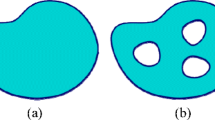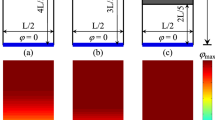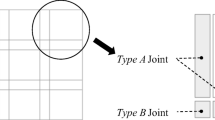Abstract
Manufacturing methods using molds, such as casting and injection molding, are widely used in industries. A basic requirement when using such manufacturing methods is that design engineers must design products so that they incorporate certain geometrical features that allow the mold parts to be removed from the created solid object. In the present study, we propose a manufacturability evaluation method especially adapted for the use of molds. To evaluate the manufacturability, we introduce fictitious physical models that are described by steady-state anisotropic advection-diffusion equations. In these fictitious physical models, material domains have a virtual source term and the advection directions are aligned with the directions along which the mold parts are parted. Void regions, where the values of all fictitious physical fields are high, then represent either undercut geometries that would prevent the mold from being released, or interior voids that cannot be cast. Consequently, manufacturability can be evaluated using these fictitious physical fields. Furthermore, in the present study, we integrate this evaluation method with topology optimization and propose a scheme for imposing a molding constraint within the topology optimization procedure. This newly proposed topology optimization method can consider the position of mold parting lines prior to the detailed optimization procedure. Several numerical examples are provided to demonstrate the validity and effectiveness of the proposed method.
Similar content being viewed by others
References
Xia Q, Shi T, Wang MY, Liu S (2010) A level set based method for the optimization of cast part. Struct Multidiscip Optim 41(5):735–747
Boothroyd G, Dewhurst P, Knight WA (2002) Product design for manufacture and assembly, 2nd edn. CRC press,
Joshi D, Ravi B (2010) Early castability evaluation using analytical hierarchy process. Int J Adv Manuf Technol 50(1):21–36
Armillotta A, Fasoli S, Guarinoni A (2016) Cold flow defects in zinc die casting: prevention criteria using simulation and experimental investigations. Int J Adv Manuf Technol 85(1):605–622
Hoque A, Halder P, Parvez M, Szecsi T (2013) Integrated manufacturing features and design-for-manufacture guidelines for reducing product cost under CAD/CAM environment. Comput Ind Eng 66(4):988–1003
James BD, Spisak AB, Colella WG (2014) Design for manufacturing and assembly cost estimate methodology for transportation fuel cell systems. J Manuf Sci Eng 136(2):024,503
Selvaraj P, Radhakrishnan P, Adithan M (2009) An integrated approach to design for manufacturing and assembly based on reduction of product development time and cost. Int J Adv Manuf Technol 42(1–2):13–29
Lu C, Zhao W H, Yu S J (2012) Concurrent tolerance design for manufacture and assembly with a game theoretic approach. Int J Adv Manuf Technol 62(1–4):303–316
Liu S G, Jin Q, Wang P, Xie R J (2014) Closed-form solutions for multi-objective tolerance optimization. Int J Adv Manuf Technol 70(9-12):1859–1866
Salonitis K (2016) Design for additive manufacturing based on the axiomatic design method. Int J Adv Manuf Technol 87(1):989–996
Prager W (1974) A note on discretized michell structures. Comput Methods Appl Mech Eng 3(3):349–355
Svanberg K (1981) Optimization of geometry in truss design. Comput Methods Appl Mech Eng 28(1):63–80
Pironneau O (1984) Optimal shape design for elliptic systems. Springer
Sokolowski J, Zolesio JP (1992) Introduction to shape optimization. Springer
Bendsøe MP, Kikuchi N (1988) Generating optimal topologies in structural design using a homogenization method. Comput Methods Appl Mech Eng 71(2):197–224
Bendsøe MP (1989) Optimal shape design as a material distribution problem. Struct Optim 1(4):193–202
Yaji K, Yamada T, Yoshino M, Matsumoto T, Izui K, Nishiwaki S (2014) Topology optimization using the lattice boltzmann method incorporating level set boundary expressions. J Comput Phys 274:158–181
Otomori M, Yamada T, Izui K, Nishiwaki S, Andkjær J (2012) A topology optimization method based on the level set method for the design of negative permeability dielectric metamaterials. Comput Methods Appl Mech Eng 237:192–211
Noguchi Y, Yamada T, Otomori M, Izui K, Nishiwaki S (2017) An acoustic metasurface design for wave motion conversion of longitudinal waves to transverse waves using topology optimization. Appl Phys Lett 107 (22):221,909
Bendsøe MP, Sigmund O (1999) Material interpolation schemes in topology optimization. Arch Appl Mech 69(9–10):635–654
Osher S, Sethian JA (1988) Fronts propagating with curvature-dependent speed: algorithms based on hamilton-jacobi formulations. J Comput Phys 79(1):12–49
Wang M Y, Wang X, Guo D (2003) A level set method for structural topology optimization. Comput Methods Appl Mech Eng 192(1):227–246
Allaire G, Jouve F, Toader A M (2004) Structural optimization using sensitivity analysis and a level-set method. J Comput Phys 194(1):363–393
Bharanidaran R, Ramesh T (2017) A modified post-processing technique to design a compliant based microgripper with a plunger using topological optimization. Int J Adv Manuf Technol :1–10
Liu J, Ma Y (2016) A survey of manufacturing oriented topology optimization methods. Adv Eng Softw 100:161–175
Poulsen T A (2003) A new scheme for imposing a minimum length scale in topology optimization. Int J Numer Methods Eng 57(6):741–760
Guest J K, Prévost J H, Belytschko T (2004) Achieving minimum length scale in topology optimization using nodal design variables and projection functions. Int J Numer Methods Eng 61(2):238–254
Zhou M, Lazarov BS, Wang F, Sigmund O (2017) Minimum length scale in topology optimization by geometric constraints. Comput Methods Appl Mech Eng 293:266–282
Guest J K (2009) Imposing maximum length scale in topology optimization. Struct Multidiscip Optim 37 (5):463–473
Chen S, Wang M Y, Liu A Q (2008) Shape feature control in structural topology optimization. Comput Aided Des 40(9):951–962
Guo X, Zhang W, Zhong W (2014) Explicit feature control in structural topology optimization via level set method. Comput Methods Appl Mech Eng 272:354–378
Allaire G, Jouve F, Michailidis G (2016) Thickness control in structural optimization via a level set method. Struct Multidiscip Optim 53(6):1349–1382
Brackett D, Ashcroft I, Hague R (2011) Topology optimization for additive manufacturing. In: Proceedings of the solid freeform fabrication symposium. Austin, pp 348–362
Leary M, Merli L, Torti F, Mazur M, Brandt M (2014) Optimal topology for additive manufacture: a method for enabling additive manufacture of support-free optimal structures. Mater Des 63:678–690
Langelaar M (2016) Topology optimization of 3d self-supporting structures for additive manufacturing. Additive Manufacturing 12:60–70
Gaynor AT, Guest JK (2016) Topology optimization considering overhang constraints: Eliminating sacrificial support material in additive manufacturing through design. Struct Multidiscip Optim:1–16
Li Q, Chen W, Liu S, Tong L (2016) Structural topology optimization considering connectivity constraint. Struct Multidiscip Optim
Zhou M, Fleury R, Shyy YK, Thomas H, Brennan J (2002) Progress in topology optimization with manufacturing constraints. In: Proceedings of the 9th AIAA MDO conference AIAA-2002-4901
Allaire G, Jouve F, Michailidis G (2017) Molding direction constraints in structural optimization via a level-set method
Yamada T, Izui K, Nishiwaki S, Takezawa A (2010) A topology optimization method based on the level set method incorporating a fictitious interface energy. Comput Methods Appl Mech Eng 199(45–48):2876–2891
Li H, Li P, Gao L, Zhang L, Wu T (2017) A level set method for topological shape optimization of 3d structures with extrusion constraints. Comput Methods Appl Mech Eng 283:615– 635
Allaire G, De Gournay F, Jouve F, Toader A (2005) Structural optimization using topological and shape sensitivity via a level set method. Control Cybern 34(1):59
Eschenauer H A, Kobelev V V, Schumacher A (1994) Bubble method for topology and shape optimization of structures. Struct Optim 8(1):42–51
Otomori M, Yamada T, Izui K, Nishiwaki S (2014) Matlab code for a level set-based topology optimization method using a reaction diffusion equation. Struct Multidiscip Optim :1–14
Allaire G (2002) Shape optimization by the homogenization method, vol 146. Springer, New York
Sigmund O (1997) On the design of compliant mechanisms using topology optimization*. J Struct Mech 25 (4):493– 524
Nishiwaki S, Frecker M I, Min S, Kikuchi N (1998) Topology optimization of compliant mechanisms using the homogenization method. Int J Numer Methods Eng 42:535–559
Acknowledgment
The authors are grateful to co-researchers in the Mitsubishi Electric Corporation for helpful discussions. The authors also sincerely appreciate the support received from the research scholar of Toyota Physical & Chemical Research Institute.
Author information
Authors and Affiliations
Corresponding author
Rights and permissions
About this article
Cite this article
Sato, Y., Yamada, T., Izui, K. et al. Manufacturability evaluation for molded parts using fictitious physical models, and its application in topology optimization. Int J Adv Manuf Technol 92, 1391–1409 (2017). https://doi.org/10.1007/s00170-017-0218-0
Received:
Accepted:
Published:
Issue Date:
DOI: https://doi.org/10.1007/s00170-017-0218-0




